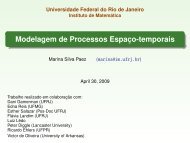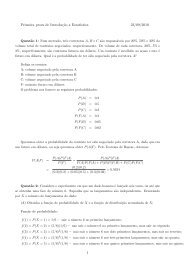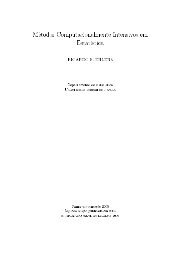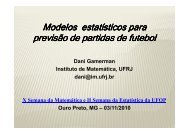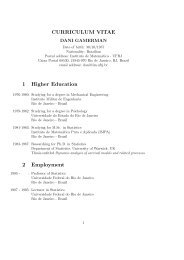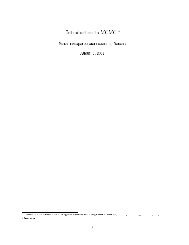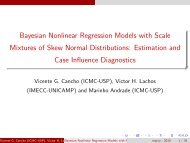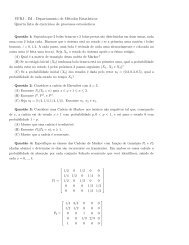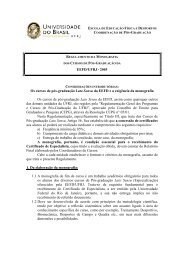Copulas: a Review and Recent Developments (2007)
Copulas: a Review and Recent Developments (2007)
Copulas: a Review and Recent Developments (2007)
You also want an ePaper? Increase the reach of your titles
YUMPU automatically turns print PDFs into web optimized ePapers that Google loves.
de¯ned on fy : y>0<strong>and</strong>(1+» y° ) > 0g. The special case of » = 0, interpreted as¾the limit case » ! 0, gives the constrained modelF (y) =1¡ expµ¡ y°¾; if » =0;for y>0. When °1 induces concavity. The Weibull distribution correspondsto » = 0. Two sub-classes of the Weibull are: the class of sub-exponential distributions,generated by letting °1.The choice of thresholds is a critical issue, not addressed here. After some experimentationobserving the st<strong>and</strong>ard errors of marginal parameters estimates, thethresholds were ¯xed as the empirical p i -quantile, (p 1 ;p 2 )=(0:18; 0:17). We note thatthe limit distributional result, the Pick<strong>and</strong>s-Balkema-de Haan theorem, given for theright tail, holds for su±ciently extreme thresholds, but high thresholds may result inlarge variability of estimators (see Embrechts et al., 1997). To estimate the marginal<strong>and</strong> copula parameters we use the fully parametric approach in two steps, for detailssee Genest et al. (1995) <strong>and</strong> Joe (1997), based on maximum likelihood estimation.We found the daily marginal (lower tail) excesses follow di®erent MGPD(°;»;¾) distributions,respectively, an MGPD(1:62; 0:56; 6:38) <strong>and</strong> an MGPD(1:32; 0:33; 1:43).These estimates <strong>and</strong> respective st<strong>and</strong>ard errors are given in Table 2. The ¯rst columngives the threshold values, the second gives the number of joint observationsused (172), <strong>and</strong> the third, fourth <strong>and</strong> ¯fth columns show the marginal results, forKorea <strong>and</strong> Singapore. The marginal excesses are not identically distributed <strong>and</strong> thusthe excesses are not exchangeable.Table 2: Margins <strong>and</strong> copula parameters estimates <strong>and</strong> (st<strong>and</strong>ard errors) <strong>and</strong> ¸U,for the negative co-exceedances of Korea <strong>and</strong> Singapore.Excess daily returns (raw data)Thresholds # ° » ¾ Copula(parameter) ¸U-1.38 -1.05 172 1.53 1.32 0.56 0.33 6.38 1.43 Gumbel(1.35) 0.33(0.08) (0.05) (0.11) (0.10) (1.32) (0.17) (0.05) (0.14)Excess residuals (¯ltered data)Thresholds # ° » ¾ Copula(parameters) ¸U-0.85 -0.87 147 1.02 1.04 0.13 0.13 0.50 0.56 ALM(1.19, 0.96, 0.82) 0.19(0.06) (0.06) (0.09) (0.08) (0.06) (0.07) (0.07, 0.02, 0.02) (0.09)For the dependence structure we considered four copula families possessing uppertail dependence. They are the Gumbel, see Joe (1997), Joe-Clayton (family BB7 inJoe (1997)), the copula associated to the Kimeldorf <strong>and</strong> Sampson or Clayton copula,thecopulapertainingtothebivariatePareto distribution, see Frees <strong>and</strong> Valdez (1998),33



